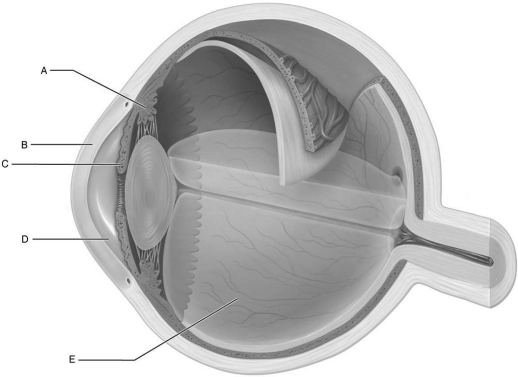A) D
B) C
C) E
D) A
E) B
Correct Answer

verified
Correct Answer
verified
Short Answer
High frequency sounds are detected when the basilar membrane is displaced near the ________.
Correct Answer

verified
Correct Answer
verified
Multiple Choice
Humans can see several thousand shades of color but have cone photoreceptors that are sensitive to only three (perhaps four) wavelengths of light.What is the best explanation for why we see so many colors?
A) Color perception is achieved by activation of various combinations between the three cone types.
B) Color perception is dependent on the millions of rods as well as cone photoreceptors.
C) Shades of color are purely psychological and learned by association with age, infants only seeing in black and white.
D) Colors are added and enhanced in the primary visual cortex of the brain.
Correct Answer

verified
Correct Answer
verified
Multiple Choice
During dark adaptation ________.
A) the cones are activated
B) rhodopsin accumulates in the rods
C) the sensitivity of the retina decreases
D) the rate of rhodopsin breakdown is accelerated
Correct Answer

verified
Correct Answer
verified
Multiple Choice
Which of the following is the best explanation for our perception of color?
A) Rods contain a single kind of visual pigment.
B) Cones come in three types, each sensitive to different wavelengths of light.
C) The foveae are densely packed with cones.
D) As many as 100 cones may converge on one ganglion cell.
Correct Answer

verified
Correct Answer
verified
Multiple Choice
Information from balance receptors goes directly to the ________.
A) brain stem reflex centers
B) visual cortex
C) motor cortex
D) back muscles
Correct Answer

verified
Correct Answer
verified
Multiple Choice
Which of the following is not a possible cause of conduction deafness?
A) impacted cerumen
B) otosclerosis
C) cochlear nerve degeneration
D) middle ear infection
Correct Answer

verified
Correct Answer
verified
True/False
Precision of eye movement is due to the fact that extrinsic eye muscle motor units contain only 8 to 12 muscle cells and in some cases as few as 2 or 3 muscle cells.
Correct Answer

verified
Correct Answer
verified
Multiple Choice
Match the following: -A condition of deafness that may result from otosclerosis.
A) Conduction deafness
B) Otitis media
C) Night blindness
D) Glaucoma
Correct Answer

verified
Correct Answer
verified
Multiple Choice
Match the following: -Can result from impacted cerumen.
A) Tinnitus
B) Sensorineural deafness
C) Conduction deafness
Correct Answer

verified
Correct Answer
verified
Multiple Choice
Which of the following taste sensations is incorrectly matched to the chemicals that produce it?
A) salty-metal ions
B) sweet-organic substances such as sugar and some lead salts
C) umami-triglycerides and fatty acids
D) bitter-alkaloids
E) sour-acids
Correct Answer

verified
Correct Answer
verified
Multiple Choice
Match the following: -Contains utricle and saccule.
A) Otoliths
B) Vestibule
C) Pharyngotympanic tube
D) Tympanic membrane
Correct Answer

verified
Correct Answer
verified
Multiple Choice
Match the following: -A condition often leading to blindness due to increased intraocular pressure.
A) Conduction deafness
B) Otitis media
C) Night blindness
D) Glaucoma
Correct Answer

verified
Correct Answer
verified
Multiple Choice
Match the following: -Ear stones.
A) Otoliths
B) Vestibule
C) Pharyngotympanic tube
D) Tympanic membrane
Correct Answer

verified
Correct Answer
verified
Multiple Choice
The cells of the retina in which action potentials are generated are the ________.
A) amacrine cells
B) ganglion cells
C) rods and cones
D) bipolar cells
Correct Answer

verified
Correct Answer
verified
Multiple Choice
 Figure 15.3
Using Figure 15.3, match the following:
-Acts as a reflexively activated diaphragm to vary pupil size.
Figure 15.3
Using Figure 15.3, match the following:
-Acts as a reflexively activated diaphragm to vary pupil size.
A) A
B) C
C) B
D) E
E) D
Correct Answer

verified
Correct Answer
verified
Multiple Choice
Ordinarily,it is not possible to transplant tissues from one person to another,yet corneas can be transplanted without tissue rejection.This is because the cornea ________.
A) has no nerve supply
B) has no blood supply
C) does not contain connective tissue
D) is not a living tissue
Correct Answer

verified
Correct Answer
verified
Multiple Choice
The first "way station" in the visual pathway from the eye,after there has been partial crossover of the fibers in the optic chiasma,is the ________.
A) visual cortex
B) superior colliculi
C) temporal lobe
D) lateral geniculate body of the thalamus
Correct Answer

verified
Correct Answer
verified
Multiple Choice
An essential part of the maculae involved in static equilibrium is (are) the ________.
A) spiral organ (of Corti)
B) otoliths
C) cupula
D) scala media
Correct Answer

verified
Correct Answer
verified
Multiple Choice
 Figure 15.3
Using Figure 15.3, match the following:
-Controls lens shape.
Figure 15.3
Using Figure 15.3, match the following:
-Controls lens shape.
A) A
B) C
C) B
D) E
E) D
Correct Answer

verified
Correct Answer
verified
Showing 81 - 100 of 147
Related Exams